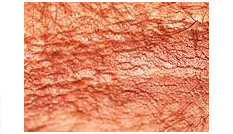







Hyperpigmented Lesions of acanthosis nigricans in armpit
This is a disorder of increased pigment. It is a skin condition characterized by hyperpigmented, thick, velvety skin in body folds and creases that occur in large patches. The skin changes appear slowly, sometimes over months or years. The patches are found, in descending order of frequency, in the axillae (armpits), neck, groin, breast folds, inner elbows, back of the knees, and around the mouth. Sometimes the palms or soles of the feet are affected as well. Interestingly, the patient usually refers to the appearance of the initial lesion as a “dirty area”, although it is certainly not dirty. Skin thickening occurs as the disease advances. Rarely, the affected areas may itch.
There is an association with obesity and the disease worsens as the patient gains weight. Acanthosis nigricans is often associated with conditions that increase your insulin level, such as type 2 diabetes or being overweight. When insulin level is too high, the extra insulin may trigger activity in your skin cells. This may cause the characteristic skin changes. Other hormone problems, endocrine disorders or tumors may play a role as well. Rarely, acanthosis nigricans is associated with certain types of cancer.
Acanthosis nigricans can begin at any age. It's more common in people who have dark skin. In some cases, acanthosis nigricans is inherited. Acanthosis nigricans occurs in 13% of African Americans, 6% of Latin Americans, and about 1% of Caucasians.There is a variant of Acanthosis Nigricans disorder with onset in adulthood that is associated with internal malignancies. The rapid onset of this disorder or large, generalized lesions should prompt the physician to search for the underlying malignancy.
Certain medications such as insulin, nicotinic acid (niacin), diethylstilbestrol, glucocorticoids, oral contraceptive pills, and methyltestosterone can contribute to the development of the condition.
There's no specific treatment for acanthosis nigricans, but treating any underlying conditions, such as diabetes and obesity, may cause the changes in the skin to fade. In all other types, treatment is extremely difficult although various topical therapies (topical retinoids, topical corticosteroids) have been tried.
>
>
>
>
>
>
>
>
>
>
>
>
>
>
>
>
>
>
>
>
>
>
>
>
>
>
INTRODUCTION
PIGMENTARY DISORDER TYPES
Disorders of
Hyperpigmentation
Disorders of Hypopigmentation
COMMON PIGMENTARY DISORDERS
Age Spots/Liver Spots/Lentigos
Acanthosis Nigricans
Albinism
Cafe-au-Lait Macules
Ephelides (Freckles)
Erythema Dyschromicum Perstans (Ashy Dermatosis)
Familial Racial Periorbital Hyperpigmentation
Idiopathic Guttate Hypomelanosis
Leopard Syndrome
Linea Nigra
Melanoma
Melasma
Nevus (birthmarks/moles)
Parkinsons Disease
Phytophotodermatits
Pityriasis Alba
Poikiloderma of Civatte
Postinflammatory
Hyperpigmentation & Hypopigmantation
Seborrheic Keratoses
Sturge-Weber Syndrome
Substance Induced
Hypermelanosis
Tinea Nigra/Tinea Versicolor/Pityriasis
Versicolor
Vitiligo
Waardenburg Syndrome

<<Previous: Age Spots/Liver Spots/Lentigos